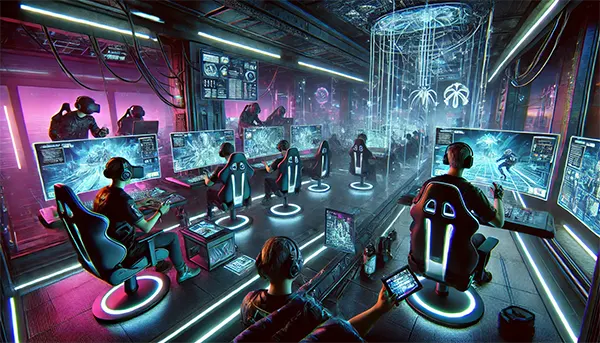The rise of the metaverse has introduced a new era for esports, blending virtual reality (VR), blockchain technology, and interactive gaming experiences. With platforms like Decentraland and The Sandbox gaining traction, traditional esports tournaments face competition from immersive, decentralised gaming environments. This article explores the impact of the metaverse on competitive gaming, the evolution of tournament formats, and the future of esports in a rapidly changing digital landscape.
Understanding the Metaverse and Its Impact on Esports
The metaverse is a digital universe where users can interact in virtual spaces through avatars, engaging in various activities, including competitive gaming. Unlike conventional multiplayer games, metaverse-based gaming environments leverage blockchain technology, non-fungible tokens (NFTs), and decentralised ownership.
Platforms like Decentraland and The Sandbox have pioneered new forms of digital interaction, allowing players to own virtual assets, trade in-game items, and participate in esports events without centralised control. These platforms promote user-generated content, leading to an evolving gaming ecosystem where esports organisations are increasingly investing.
The integration of metaverse elements into esports opens doors for innovative monetisation strategies. With the ability to buy, sell, and trade in-game assets using cryptocurrencies, professional gamers and tournament organisers have new revenue streams beyond sponsorships and prize pools.
New Competition Formats in Virtual Reality and Augmented Reality
Esports in the metaverse is not limited to traditional gaming screens. Virtual reality (VR) and augmented reality (AR) are reshaping how players compete and how audiences engage with tournaments. Unlike standard live streams, VR-enabled tournaments provide a fully immersive experience, allowing spectators to watch games from within the virtual environment.
Games such as VR-based first-person shooters and mixed-reality battle arenas are gaining popularity, offering deeper player engagement and redefining competition formats. These developments challenge the dominance of traditional PC and console-based esports tournaments, introducing a more interactive way to experience competitive gaming.
Additionally, AR integration in esports could enhance live tournaments by overlaying digital elements on real-world environments. This hybrid approach allows fans to interact with players and in-game elements in real time, potentially attracting a broader audience.
Can Traditional Esports Tournaments Compete with the Metaverse?
Classic esports tournaments, such as those hosted by organisations like ESL, DreamHack, and Riot Games, have long been the backbone of competitive gaming. These events attract millions of viewers and offer structured competitions with significant prize pools.
However, as metaverse-based esports events grow in popularity, traditional tournaments must adapt to remain relevant. The key challenge lies in retaining audiences who are drawn to the decentralised nature, unique assets, and immersive experiences offered by metaverse gaming.
To compete with metaverse-driven gaming, traditional tournament organisers are exploring hybrid models. Some esports organisations are integrating VR elements into their events, while others are experimenting with blockchain-based rewards and digital collectibles to enhance fan engagement.
The Shift in Audience Engagement and Monetisation Strategies
One of the biggest advantages of metaverse-based esports is the ability to create personalised experiences for fans. Unlike traditional tournaments, where audience interaction is limited to live streams and social media, metaverse platforms allow direct engagement with players and digital assets.
Monetisation is also evolving. In the metaverse, players and spectators can buy virtual merchandise, participate in token-based economies, and own shares in gaming organisations through decentralised finance (DeFi). This shift is making esports a more community-driven industry.
Additionally, the concept of “play-to-earn” gaming models, where players earn cryptocurrency or NFTs through participation, is gaining traction. This development further challenges conventional esports prize structures, attracting both casual gamers and professional competitors.

Investments and Future Predictions for Metaverse Esports
Major brands and technology companies are recognising the potential of metaverse-based esports. Leading gaming corporations, including Meta, Microsoft, and Epic Games, have invested heavily in virtual world development, aiming to shape the next generation of digital entertainment.
Traditional esports organisations are also expanding into the metaverse, collaborating with blockchain-based platforms to create exclusive virtual tournaments and digital experiences. These partnerships signal a shift in competitive gaming towards a decentralised and immersive future.
Experts predict that by 2025, metaverse-based esports could rival traditional tournaments in viewership and revenue. With the rapid adoption of VR and AR technologies, the gap between classic esports and metaverse gaming will likely continue to narrow.
Challenges and Barriers to Metaverse Esports Growth
Despite its potential, metaverse esports faces challenges, including high hardware costs, limited accessibility, and regulatory concerns. VR and AR equipment remain expensive for many players, hindering mass adoption.
Moreover, the decentralised nature of metaverse gaming raises issues related to security, fraud, and intellectual property rights. With esports organisations and brands investing in digital assets, maintaining a fair and transparent ecosystem will be crucial.
Nevertheless, as technology advances and costs decrease, the metaverse is poised to become a significant force in the future of esports. Traditional tournaments will need to innovate and embrace new formats to stay competitive in this evolving landscape.
